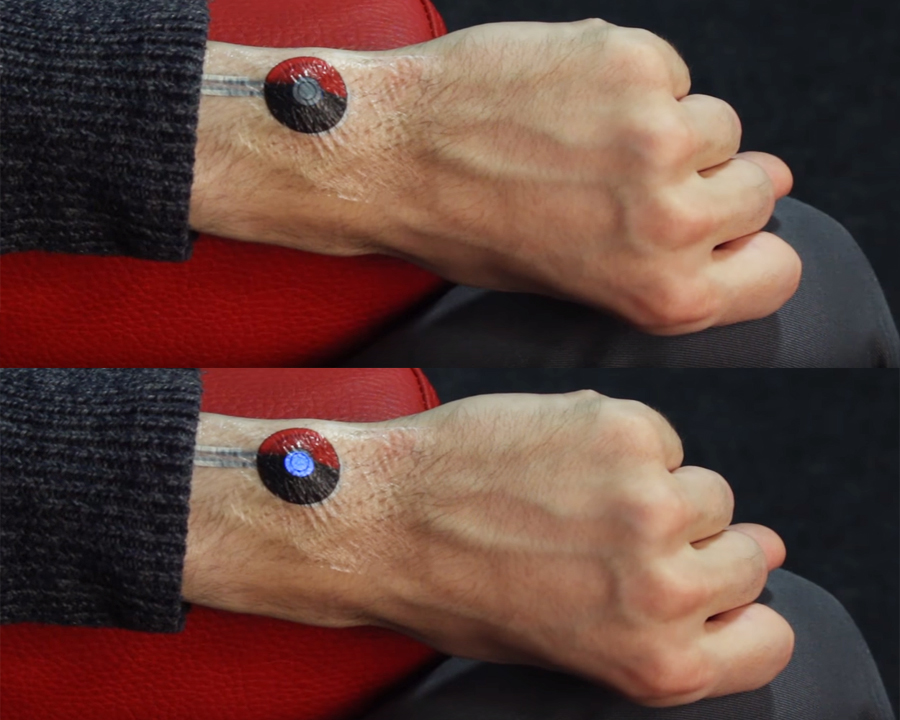 ard that comes in the shape of a temporary tattoo. Known as SkinMarks, these incredibly thin e-tattoos would turn a person’s skin into a touch-sensitive control, meant primarily for interacting with digital devices.
ard that comes in the shape of a temporary tattoo. Known as SkinMarks, these incredibly thin e-tattoos would turn a person’s skin into a touch-sensitive control, meant primarily for interacting with digital devices.
If the invention works, SkinMarks could be one of the first steps on the road to creating genuine human cyborgs. Already, 85% of Americans between 18-29 years own a smartphone, and many of them are practically attached to their tech already. These electronic tattoos could change the way they interact with these devices. Gone will be the days when a person had to physically hold their phone, and in will be the age when a simple brush of a finger across the skin can play music or open apps.

Most printed circuit boards are made with an epoxy resin reinforced with fiberglass (such as FR4), while some mass produced PCBs are made from paper reinforced phenolic resin (such as FR-1 and FR-2). Generally, these materials can withstand temperatures between 105 to 130 degrees Celsius, which would cause serious burns to human skin. These new PCBs sidestep this issue by using an entirely different set of materials.
The tattoos themselves are actually quite simple, as the researchers have found a way to utilize the elasticity of a person’s skin to further add to the flexibility of the circuit board. They are able to use conductive ink to print flexible, bendable, and stretchable wires and electrodes on temporary tattoo paper.
Cyborgs, or “enhanced” human beings whose bodies are fused with technology, have long been popular in science fiction stories. For now, these e-tattoos only affect the top-most layer of skin, known as the epidermis, which is only one-tenth of a millimeter thick. And unlike real tattoos, these e-tattoos are temporary. Because people shed about 1 million skin cells daily, the epidermis completely replenishes itself in 27 to 60 days. However, the e-tattoos don’t even last that long. When printed, the tattoos are applied to the skin using water and some pressure, and the ink can only last a couple days before disintegrating.
These impressive little tattoos are thinner than the width of a human hair, Futurism reports. SkinMarks are meant to work with every skin tone and can even be used on unsightly bumps, wrinkles, or birthmarks — the texture of the skin doesn’t matter. Rather, it is how the user moves their skin; the features of the tattoo change when put in different positions.
For example, the German researchers have created one e-tattoo that is meant to be placed along the side of a finger. When the finger is held straight, the user can slide another finger across the tattoo to raise or lower the volume on their smartphone. But when bent, the tattoo becomes a play and pause button. This versatility means not only can a tattoo be placed anywhere on the body, they can be used for more than one function, which cuts down cost and improves user experience.
There are other e-tattoos on the market, but SkinMarks stands out because of its electroluminescent properties. This means that the tattoo glows whenever a current is passing through it, and this feature can be customized for each user. For instance, a person could have a tattoo of their favorite social media app on their forearm, and whenever they get a notification, the app will light up.
So when can the world be introduced to these mini touch screens? The biggest barrier comes with manufacturing — as scientists are having a hard time creating this advanced technology while still staying relatively inexpensive.
But there have been some successful attempts in the past.
Edgy Labs reports that researchers at the Waseda University in Japan developed a method of using electronic tattoos via everyday inkjet printers. Instead of creating an overall flexible unit, the researchers would make the electrical contacts that connected the components flexible. Meanwhile, scientists at MIT recently discovered that gold metal leaf works as the perfect conductor for a flexible interface. Experiments are being conducted right now across the world to find the best material for the e-tattoos of the future.
However, Chris Harrison, a researcher at Carnegie Mellon University, predicts to New Science that products like SkinMarks will become a viable option for consumers within a decade.
He explained, “You’ll have these digital tattoo parlors which you can go to in 2050 and 5 minutes later you can walk out with the iPhone 22 on your forearm.”
The future can’t come soon enough.






